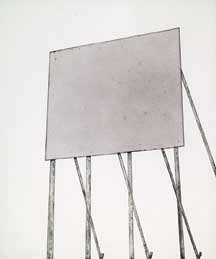|

YOUR SPACE #2, 2006
29.75 x 25 inches
Color aquatint with sugar lift flat bite and hard ground etching
Edition of 30
$9,500
Edward Ruscha
Born 1937, Omaha, Nebraska, U.S.A.
Lives and works in Los Angeles
'When I first became attracted to the idea of being an artist,' Ed Ruscha once said, 'painting was the last method, it was an almost obsolete, archaic form of communication ... I felt newspapers, magazines, books, words, to be more meaningful than what some damn oil painter was doing'.
In the course of his career Ed Ruscha has, more than any other artist, dazzled us with the visual and textual potential of language. Brimming with multiple meanings, unlikely marriages of word and image, and an unmatched feeling for vernacular speech, his works - which span media from painting to film - are among the smartest cultural products of the last half-century.
In the early 60s, Ruscha's work was pivotal both in registering the paradigm shift from Abstract Expressionism to Pop, and in crystallizing the distinct identity of West Coast art. Compared to New York-based artists, like Andy Warhol and Roy Lichtenstein, Ruscha's take on pop aesthetics was refined and restrained. While his earliest 'word paintings' staged bathetic conflicts between psuedo-expressionist splatters and emblems of everyday life — such as Spam tins, comics and newspapers - his work soon became increasingly streamlined and, on occasion, revealed itself as an exquisitely understated homage to the quotidian world. For example, the painting Noise, Pencil, Broken Pencil, Cheap Western of 1963 scattered its pictorial elements - two pencils, a photorealist rendition of a comic book, and the word 'Noise' in 3D letters - to the edges of a deep blue, void-like canvas. While on the one hand leading painting into a cool, matter-of-fact realm (all the objects were painted life—size) Ruscha was also ironically positioning mass-cultural products as noise.
At the same time, Ruscha began his now-celebrated series of photographic books, which he describes as 'some of the toughest things I've done ... they operated in a medium that had no art life.' Works such as Twentysix Gasoline Stations (1963), Every Building on the Sunset Strip (1966) and Nine Swimming Pools and a Broken Glass (1968) were taxonomical and apparently artless collections of images that recorded the architectural environs of Los Angeles. In presenting the warp and weave of LA simply as it was, these conceptual works were a local axis around which Ruscha's increasingly rangy practice revolved.
By the mid to late 60s, continuing a tendency towards pictorial pyromania that had previously been rehearsed in the book Various Small Fires, he was making realist paintings such as The Los Angeles County Museum on Fire, as well as impossible paintings in which words seemed to be formed from droplets of water, and trompe l'oeil drawings using gunpowder, in which three-dimensional words such as 'L'Amour' and 'Opera!' were apparently formed from curled strips of paper. This dialectic between unlikely word and even more unlikely material continued through the 70s, as Ruscha visualized such evocative phrases as 'Vanishing Cream' and 'Sand in the Vaseline' by silk—screening substances like egg yolk and cherry onto moire.
By the early 80s, after experimenting with synchronism - while the phrase 'A Certain Form of Hell' floated over a toxic, depthless sunset, the rejoinder 'Not A Bad World, Is It?' was superimposed onto a country landscape - Ruscha had adopted a studied ambivalence that proved most productive. His airbrushed, monochrome images of the mid 80s to late 90s explored innumerable avenues of possibility: from 17th Century gothic expressions spread over blackened clouds, to the wonderfully ambiguous line 'Brave Men Run in My Family', which captioned a silhouetted sailing ship on a tempestuous ocean. In several cases the text is obscured by blocks, which makes the works even more playful.
More recently Ruscha has returned to color and, in a number of visually gorgeous works that superimpose words over images of mountains, engaged with the sublime. His approach, however, remains remarkably consistent; language is plucked from the ether and then utilized within image-text combinations whose poetic associations reverberate, multiply exponentially, and deliver to the viewer a plethora of pleasurable ambiguities.
|